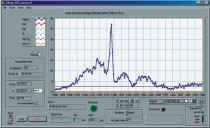
Features
- High S/N ratio due to the superb laser source stability
- Better than 6 cm⁻¹ spectral resolution
- Cost-effective picosecond system approach
- Complete PC control
- Acquisition of SFG spectra in wide wavelength range: 4300 – 625 cm⁻¹
- Monitoring of surface dynamics
- Azimuth scan, XY-mapping of the sample (optional)
- Models with 10, 20 or 50 Hz pulse repetition rate
- Double resonance SFG model with tunable visible beam
Applications
- Investigation of surfaces and interfaces of solids, liquids, polymers, biological membranes and other systems
- Studies of surface structure, chemical composition and molecular orientation
- Remote sensing in hostile environment
- Investigation of surface reactions under real atmosphere, catalysis, surface dynamics
- Studies of epitaxial growth, electrochemistry, material and environmental problems
- Your own application...
Powerful and versatile tool for in-situ investigation of surfaces and interfaces:
- Intrinsically surface specific
- Selective to adsorbed species
- Sensitive to submonolayer of molecules
- Applicable to all interfaces accessible to light
- Nondestructive
- Capable of high spectral and spatial resolution
Picosecond sum-frequency generation (SFG) spectrometer from EKSPLA is an ideal tool in laser spectroscopy for in-situ investigation of surfaces and interfaces. The SFG spectrometer operates from 4300 to 625 cm⁻¹ and provides < 6 cm⁻¹ spectral resolution.
Basic operation principles of SFG spectroscopy
In SFG experiment a pulsed tunable infrared IR (ωIR) laser beam is mixed with a visible VIS (ωVIS) beam to produce an output at the sum frequency (ωSFG = ωIR + ωVIS).

SFG is second-order nonlinear process, which is allowed only in media without inversion symmetry. At surfaces or interfaces inversion symmetry is necessarily broken, that makes SFG highly surface specific.
As the IR wavelength is scanned, active vibrational modes of molecules at the interface give a resonant contribution to SFG signal. The resonant enhancement provides spectral information on surface characteristic vibrational transitions.
Different combinations of input and output beam polarizations allow the determination of surface symmetry or molecular orientation.
SFG detects vibrational modes, which are rather localized to specific groups of atoms within the molecules. Information about relative orientation of different groups within the same molecule maybe obtained, and, hence, the molecular structure can be deducted.
Referring to the SFG signal phase measurements, information about the absolute orientation of molecule in respect to the surface can be obtained.
Design of the SFG spectrometer
Sum frequency excitation system is based on picosecond pump laser and optical parametric generator/amplifier/ difference frequency generator (OPG/OPA/DFG).
Solid state mode-locked Nd:YAG laser featuring high pulse duration and energy stability is used to pump the system. Second harmonic (532 nm) of laser fundamental radiation is used as VIS pump beam for sum frequency generation.
Tunable IR radiation is generated in three stage optical parametric generator / amplifier / difference frequency generator. Spectral and spatial filtration of OPG seed beam provides narrow bandwidth and low divergency of mid-IR radiation. Beam walk-off compensation design ensures overlaping pump beams over the full wavelength range.
VIS beam delivery optics includes: spatial filter for homogenous beam profile, energy and polarization control system for smooth adjustment of pulse energy and polarization direction, delay line for temporal overlap of VIS and IR pulses.
IR beam delivery optics include mirror based polarization control and beam delivery systems.
The energy of both the VIS and IR beams is monitored by photodetectors for SFG signal normalization.
Optional 6 axis (three translational and three rotational) including PC controlled X ,Y and θ axes stage enables sample mapping and investigation of molecules orientation.
SF guiding optics includes steering mirrors, focusing lens, polarization analyser and holographic notch filter for scattered VIS light rejection.
Detection system consists of monochromator and gated PMT based SF signal detector.
Low power laser diode guiding beam is integrated for alignment convenience.
Optional reference channel improves the signal/noise ratio for samples with high non-resonant background.

SFG spectrometer includes :
- Picosecond Nd:YAG laser
- Optical parametric generator / amplifier /difference frequency generator (OPG/OPA/DFG)
- Beams delivery optics
- Monochromator
- PMT or CCD signal detectors
- Data acquisition system
- Control software
- Guiding beam for system alignment
Optional accessories:
- Reference channel
- Six axis sample holder (manual or three axes (X, Y and θ) PC controlled)
- Sample area purge box
- Sealed temperature controlled sample chamber
Software
All the spectrometer units (laser, optical parametric generator / amplifier / difference frequency generator (OPG/OPA/DFG), monochromators, photodetectors) are controlled from computer using LabVIEW™ environment.
Spectrometer software features SFG spectra acquisition, azimuth scan, XY-mapping, surface dynamics investigation. OPG/OPA/DFG and monochromator calibration options are available.

Double resonance model
Both IR and VIS wavelengths are tunable in double resonance SFG option. This two-dimensional spectroscopy is more selective than single resonant SFG and applicable even to media with strong fluorescence. Double resonant SFG allows investigation of vibrational mode coupling to electron states at a surface.
In double resonance SFG spectrometer model second OPG/OPA is used to generate tunable VIS beam in 210 – 680 nm range.
SFG spectrometer options
Spectral resolution down to 2 cm-1
Using narrowband OPO/OPA/DFG with synchronously pumped parametric oscillator decreases SFG spectral resolution down to 2 cm-1.
Second harmonic generation (SHG) spectrometer
Second harmonic generation (SHG) is an effective tool for surface probing. The monolayer adsorbtion may be detected by SHG. With different input/output beam polarizations SHG yield information on the average orientation of molecular adsorbates. The surface symmetry measurements can be performed by rotation of the sample around the surface normal. By using tunable lasers, SHG establishes itself as powerfull tool for surface-specific electronic transitions spectroscopy. SHG spectrometer is available as accessory to the SFG spectrometer or stand-alone system. Learn more about SHG... | 
